Boya Di
Intelligent Reflecting Surface Based Localization of Mixed Near-Field and Far-Field Targets
Feb 04, 2025



Abstract:This paper considers an intelligent reflecting surface (IRS)-assisted bi-static localization architecture for the sixth-generation (6G) integrated sensing and communication (ISAC) network. The system consists of a transmit user, a receive base station (BS), an IRS, and multiple targets in either the far-field or near-field region of the IRS. In particular, we focus on the challenging scenario where the line-of-sight (LOS) paths between targets and the BS are blocked, such that the emitted orthogonal frequency division multiplexing (OFDM) signals from the user reach the BS merely via the user-target-IRS-BS path. Based on the signals received by the BS, our goal is to localize the targets by estimating their relative positions to the IRS, instead of to the BS. We show that subspace-based methods, such as the multiple signal classification (MUSIC) algorithm, can be applied onto the BS's received signals to estimate the relative states from the targets to the IRS. To this end, we create a virtual signal via combining user-target-IRS-BS channels over various time slots. By applying MUSIC on such a virtual signal, we are able to detect the far-field targets and the near-field targets, and estimate the angle-of-arrivals (AOAs) and/or ranges from the targets to the IRS. Furthermore, we theoretically verify that the proposed method can perfectly estimate the relative states from the targets to the IRS in the ideal case with infinite coherence blocks. Numerical results verify the effectiveness of our proposed IRS-assisted localization scheme. Our paper demonstrates the potential of employing passive anchors, i.e., IRSs, to improve the sensing coverage of the active anchors, i.e., BSs.
Simultaneous Beamforming and Anti-Jamming With Intelligent Omni-Surfaces
Feb 04, 2025Abstract:Wireless transmission is vulnerable to malicious jamming attacks due to the openness of wireless channels, posing a severe threat to wireless communications. Current anti-jamming studies primarily focus on either enhancing desired signals or mitigating jamming, resulting in limited performance. To address this issue, intelligent omni-surface (IOS) is a promising solution. By jointly designing its reflective and refractive properties, the IOS can simultaneously nullify jamming and enhance desired signals. In this paper, we consider an IOS-aided multi-user anti-jamming communication system, aiming to improve desired signals and nullify jamming by optimizing IOS phase shifts and transmit beamforming. However, this is challenging due to the coupled and discrete IOS reflection and refraction phase shifts, the unknown jammer's beamformer, and imperfect jammer-related channel state information. To tackle this, we relax IOS phase shifts to continuous states and optimize with a coupling-aware algorithm using the Cauchy-Schwarz inequality and S-procedure, followed by a local search to recover discrete states. Simulation results show that the proposed scheme significantly improves the sum rate amid jamming attacks.
Directivity-Aware Degrees of Freedom Analysis for Extremely Large-Scale MIMO
Dec 19, 2024
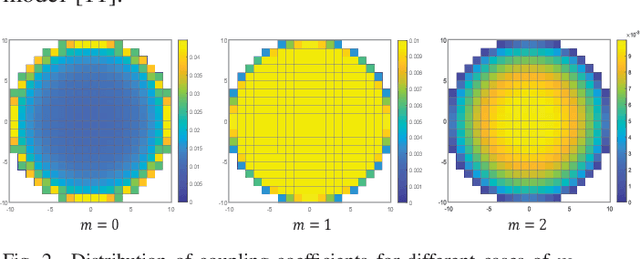
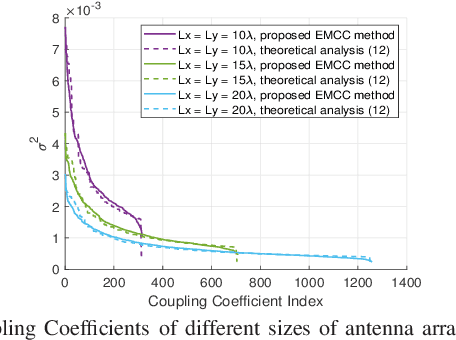

Abstract:Extremely large-scale multiple-input multiple-output (XL-MIMO) communications, enabled by numerous antenna elements integrated into large antenna surfaces, can provide increased effective degree of freedom (EDoF) to achieve high diversity gain. However, it remains an open problem that how the EDoF is influenced by the directional radiation pattern of antenna elements. In this work, empowered by the wavenumber-domain channel representation, we analyze the EDoF in a general case where the directivity of antennas, determined by the antenna structure and element spacing, is considered. Specifically, we first reveal the uneven distribution of directivity-aware wavenumber-domain coupling coefficients, i.e., channel gain towards different directions, in the isotropic Rayleigh fading channel. EDoF is then calculated based on such distribution of coupling coefficients. A numerical method is also provided to obtain coupling coefficients via electromagnetic full-wave simulations. Due to the influence of antenna directivity, how EDoF and ergodic channel capacity vary with the element spacing are explored via simulations for different antenna types.
Disco Intelligent Omni-Surfaces: 360-degree Fully-Passive Jamming Attacks
Nov 20, 2024



Abstract:Intelligent omni-surfaces (IOSs) with 360-degree electromagnetic radiation significantly improves the performance of wireless systems, while an adversarial IOS also poses a significant potential risk for physical layer security. In this paper, we propose a "DISCO" IOS (DIOS) based fully-passive jammer (FPJ) that can launch omnidirectional fully-passive jamming attacks. In the proposed DIOS-based FPJ, the interrelated refractive and reflective (R&R) coefficients of the adversarial IOS are randomly generated, acting like a "DISCO" that distributes wireless energy radiated by the base station. By introducing active channel aging (ACA) during channel coherence time, the DIOS-based FPJ can perform omnidirectional fully-passive jamming without neither jamming power nor channel knowledge of legitimate users (LUs). To characterize the impact of the DIOS-based PFJ, we derive the statistical characteristics of DIOS-jammed channels based on two widely-used IOS models, i.e., the constant-amplitude model and the variable-amplitude model. Consequently, the asymptotic analysis of the ergodic achievable sum rates under the DIOS-based omnidirectional fully-passive jamming is given based on the derived stochastic characteristics for both the two IOS models. Based on the derived analysis, the omnidirectional jamming impact of the proposed DIOS-based FPJ implemented by a constant-amplitude IOS does not depend on either the quantization number or the stochastic distribution of the DIOS coefficients, while the conclusion does not hold on when a variable-amplitude IOS is used. Numerical results based on one-bit quantization of the IOS phase shifts are provided to verify the effectiveness of the derived theoretical analysis. The proposed DIOS-based FPJ can not only launch omnidirectional fully-passive jamming, but also improve the jamming impact by about 55% at 10 dBm transmit power per LU.
Holographic-Pattern Based Multi-User Beam Training in RHS-Aided Hybrid Near-Field and Far-Field Communications
Nov 07, 2024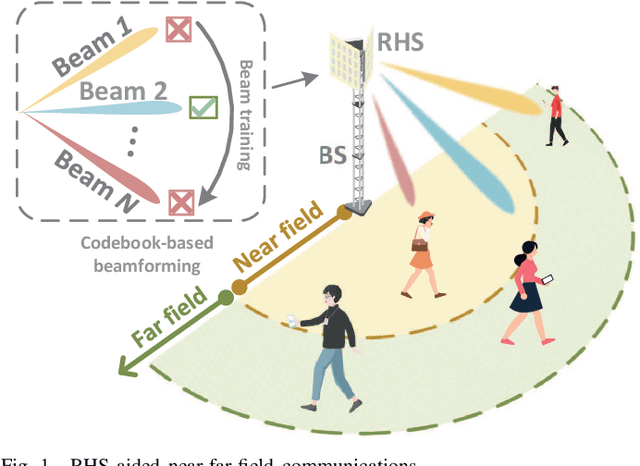
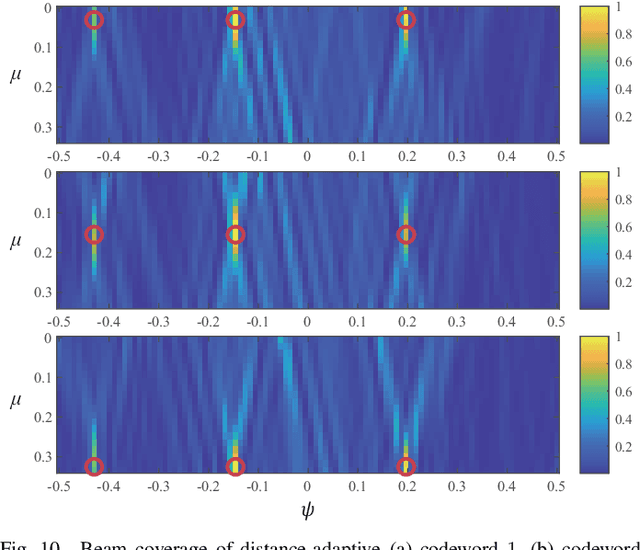
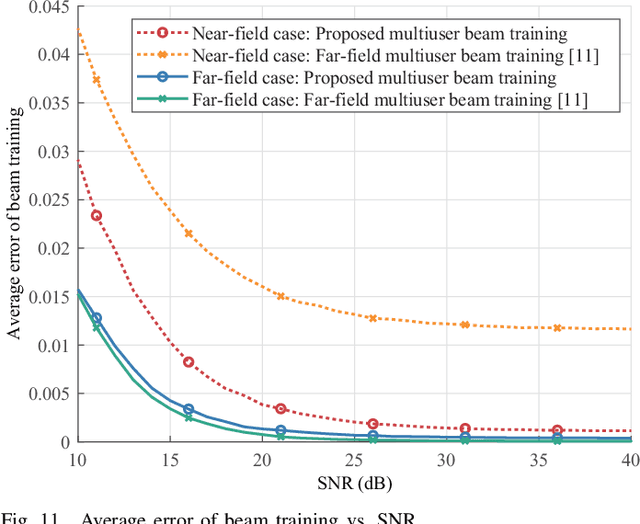
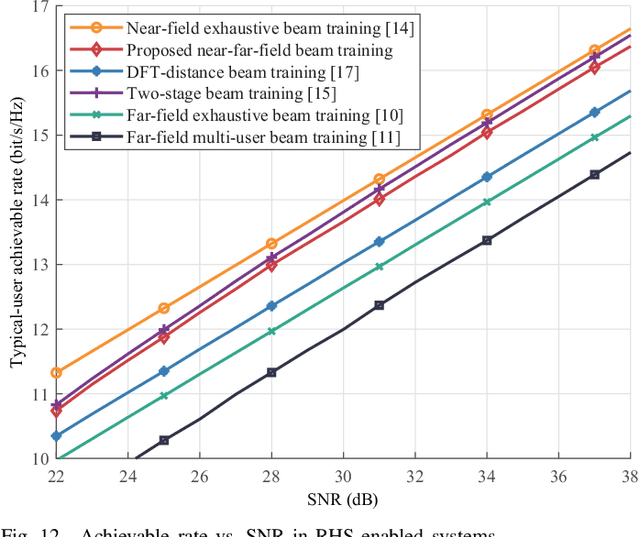
Abstract:Reconfigurable holographic surfaces (RHSs) have been suggested as an energy-efficient solution for extremely large-scale arrays. By controlling the amplitude of RHS elements, high-gain directional holographic patterns can be achieved. However, the complexity of acquiring real-time channel state information (CSI) for beamforming is exceedingly high, particularly in large-scale RHS-assisted communications, where users may distribute in the near-field region of RHS. This paper proposes a one-shot multi-user beam training scheme in large-scale RHS-assisted systems applicable to both near and far fields. The proposed beam training scheme comprises two phases: angle search and distance search, both conducted simultaneously for all users. For the angle search, an RHS angular codebook is designed based on holographic principles so that each codeword covers multiple angles in both near-field and far-field regions, enabling simultaneous angular search for all users. For the distance search, we construct the distance-adaptive codewords covering all candidate angles of users in a real-time way by leveraging the additivity of holographic patterns, which is different from the traditional phase array case. Simulation results demonstrate that the proposed scheme achieves higher system throughput compared to traditional beam training schemes. The beam training accuracy approaches the upper bound of exhaustive search at a significantly reduced overhead.
Large Models for Aerial Edges: An Edge-Cloud Model Evolution and Communication Paradigm
Aug 09, 2024Abstract:The future sixth-generation (6G) of wireless networks is expected to surpass its predecessors by offering ubiquitous coverage through integrated air-ground facility deployments in both communication and computing domains. In this network, aerial facilities, such as unmanned aerial vehicles (UAVs), conduct artificial intelligence (AI) computations based on multi-modal data to support diverse applications including surveillance and environment construction. However, these multi-domain inference and content generation tasks require large AI models, demanding powerful computing capabilities, thus posing significant challenges for UAVs. To tackle this problem, we propose an integrated edge-cloud model evolution framework, where UAVs serve as edge nodes for data collection and edge model computation. Through wireless channels, UAVs collaborate with ground cloud servers, providing cloud model computation and model updating for edge UAVs. With limited wireless communication bandwidth, the proposed framework faces the challenge of information exchange scheduling between the edge UAVs and the cloud server. To tackle this, we present joint task allocation, transmission resource allocation, transmission data quantization design, and edge model update design to enhance the inference accuracy of the integrated air-ground edge-cloud model evolution framework by mean average precision (mAP) maximization. A closed-form lower bound on the mAP of the proposed framework is derived, and the solution to the mAP maximization problem is optimized accordingly. Simulations, based on results from vision-based classification experiments, consistently demonstrate that the mAP of the proposed framework outperforms both a centralized cloud model framework and a distributed edge model framework across various communication bandwidths and data sizes.
Hybrid Near-Far Field Channel Estimation for Holographic MIMO Communications
Jul 17, 2024Abstract:Holographic MIMO communications, enabled by large-scale antenna arrays with quasi-continuous apertures, is a potential technology for spectrum efficiency improvement. However, the increased antenna aperture size extends the range of the Fresnel region, leading to a hybrid near-far field communication mode. The users and scatterers randomly lie in near-field and far-field zones, and thus, conventional far-field-only and near-field-only channel estimation methods may not work. To tackle this challenge, we demonstrate the existence of the power diffusion (PD) effect, which leads to a mismatch between the hybrid-field channel and existing channel estimation methods. Specifically, in far-field and near-field transform domains, the power gain of one channel path may diffuse to other positions, thus generating fake paths. This renders the conventional techniques unable to detect those real paths. We propose a PD-aware orthogonal matching pursuit algorithm to eliminate the influence of the PD effect by identifying the PD range within which paths diffuse to other positions. PD-OMP fits a general case without prior knowledge of near-field and far-field path numbers and the user's location. The computational complexity of PD-OMP and the Cramer-Rao Lower Bound for the sparse-signal-recovery-based channel estimation are also derived. Simulation results show that PD-OMP outperforms state-of-the-art hybrid-field channel estimation methods.
Multi-target Detection for Reconfigurable Holographic Surfaces Enabled Radar
Jan 17, 2024Abstract:Multi-target detection is one of the primary tasks in radar-based localization and sensing, typically built on phased array antennas. However, the bulky hardware in the phased array restricts its potential for enhancing detection accuracy, since the cost and power of the phased array can become unaffordable as its physical aperture scales up to pursue higher beam shaping capabilities. To resolve this issue, we propose a radar system enabled by reconfigurable holographic surfaces (RHSs), a novel meta-surface antenna composed of meta-material elements with cost-effective and power-efficient hardware, which performs multi-target detection in an adaptive manner. Different from the phase-control structure in the phased array, the RHS is able to apply beamforming by controlling the radiation amplitudes of its elements. Consequently, traditional beamforming schemes designed for phased arrays cannot be directly applied to RHSs due to this structural difference. To tackle this challenge, a waveform and amplitude optimization algorithm (WAOA) is designed to jointly optimize the radar waveform and RHS amplitudes in order to improve the detection accuracy. Simulation results reveal that the proposed RHS-enabled radar increases the probability of detection by 0.13 compared to phased array radars when six iterations of adaptive detection are performed given the same hardware cost.
Reconfigurable Holographic Surface Aided Wireless Simultaneous Localization and Mapping
Jan 16, 2024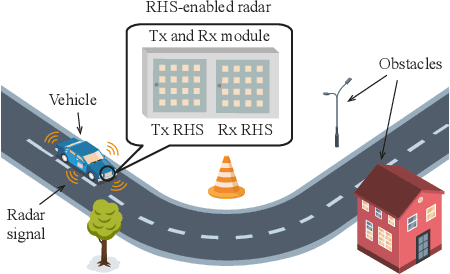
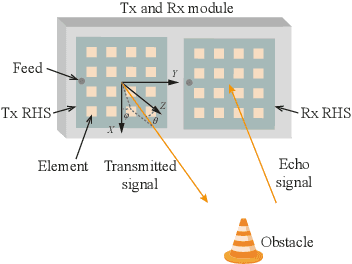
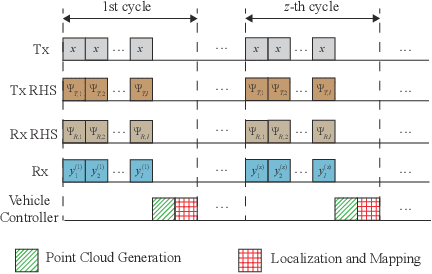
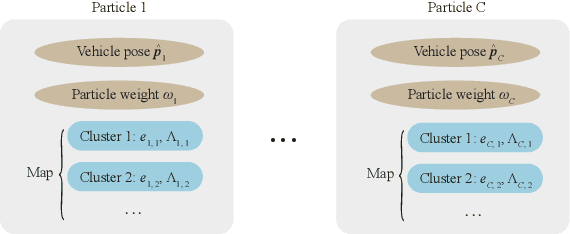
Abstract:As a crucial facilitator of future autonomous driving applications, wireless simultaneous localization and mapping (SLAM) has drawn growing attention recently. However, the accuracy of existing wireless SLAM schemes is limited because the antenna gain is constrained given the cost budget due to the expensive hardware components such as phase arrays. To address this issue, we propose a reconfigurable holographic surface (RHS)-aided SLAM system in this paper. The RHS is a novel type of low-cost antenna that can cut down the hardware cost by replacing phased arrays in conventional SLAM systems. However, compared with a phased array where the phase shifts of parallelfed signals are adjusted, the RHS exhibits a different radiation model because its amplitude-controlled radiation elements are series-fed by surface waves, implying that traditional schemes cannot be applied directly. To address this challenge, we propose an RHS-aided beam steering method for sensing the surrounding environment and design the corresponding SLAM algorithm. Simulation results show that the proposed scheme can achieve more than there times the localization accuracy that traditional wireless SLAM with the same cost achieves.
Channel Estimation for Holographic Communications in Hybrid Near-Far Field
Jan 16, 2024



Abstract:To realize holographic communications, a potential technology for spectrum efficiency improvement in the future sixth-generation (6G) network, antenna arrays inlaid with numerous antenna elements will be deployed. However, the increase in antenna aperture size makes some users lie in the Fresnel region, leading to the hybrid near-field and far-field communication mode, where the conventional far-field channel estimation methods no longer work well. To tackle the above challenge, this paper considers channel estimation in a hybrid-field multipath environment, where each user and each scatterer can be in either the far-field or the near-field region. First, a joint angular-polar domain channel transform is designed to capture the hybrid-field channel's near-field and far-field features. We then analyze the power diffusion effect in the hybrid-field channel, which indicates that the power corresponding to one near-field (far-field) path component of the multipath channel may spread to far-field (near-field) paths and causes estimation error. We design a novel power-diffusion-based orthogonal matching pursuit channel estimation algorithm (PD-OMP). It can eliminate the prior knowledge requirement of path numbers in the far field and near field, which is a must in other OMP-based channel estimation algorithms. Simulation results show that PD-OMP outperforms current hybrid-field channel estimation methods.
 Add to Chrome
Add to Chrome Add to Firefox
Add to Firefox Add to Edge
Add to Edge